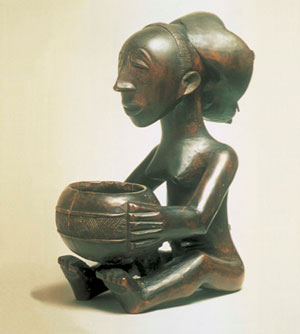
Divination is a family or community inquiry about the nature or causes of misfortune, to determine whether sickness is "just there" or whether it is "human caused." Most cases of sickness are assumed to "just happen." Recourse to a diviner occurs when therapy is not efficacious, or in connection with conflict or disaster. Diviners, family leaders, and other ritualists address the underlying causes of the misfortune and may guide the patient toward a course of healing. The visitor should be able to perceive the logical situation of divination within problematic cases of the previous section, or within the full discourse of the next section, “where something else is going on.” The goal of this section is therefore to familiarize the audience with some examples of divination paraphernalia from the Penn Museum’s collections, and to explain how it is used to answer the “why” question of misfortune.

Divination Across the African Continent begins with a depiction of a divination session shown in a painting from Senegal of a contemporary Wolof diviner and a client. The other objects exhibited in this section are used for divination and stem from a wide range of cultures across the continent, reflecting the widespread use of divination in connection with healing in Africa: the paraphernalia of divination in the Ifa tradition of the Yoruba peoples of Nigeria (an elaborately carved bowl with a lid to hold the shells or nuts that are used in the divination throw to elicit the verbal epithets of the insight; an Apo Ifa beaded bag to store the shells; an Opon Ifa divination tray onto which the shells are thrown, and the tapper that is used in rousing the spirit that guides the "reading" of the constellations of shells; a sculpted female figure used in Luba Mboko divination (Southern Savanna, Congo) with a bowl containing chalk, which is associated with the beneficence of the spirit world; a Kuba Itombwa wooden dog figure from the Kasai region of the Southern Savanna that is used in divination involving friction; a basket with about 40 symbolic figures from the Ovimbundu people of Eastern Angola of the widespread Ngombo divination tradition that covers societies from the Atlantic coast to the Ndembu of northern Zambia (each symbol and constellations of symbols in the basket represent particular circumstances in individual and social life that the diviner "reads" to make an interpretation of a particular case). Finally, from the National Museum of Botswana, a collaborating institution in Africa, the exhibition includes a set of "bones" and a bag used by zingaka, amagqira, or sangoma (thus over a wide region of Southern Africa) to interpret misfortunes of clientele in a procedure known as "throwing the bones."
The array of displays of these various divination techniques will be amplified and clarified for the viewer by still photographs and a film depicting at least one of these traditions. Divination sessions are often public and are held in the out-of-doors, with clients seated on the ground. The arrangement of the display cases will suggest a divination place or courtyard that allows a guide to stage a teaching moment for a visiting group in this setting.
A contemporary painting by the Congolese painter Shula, Sorcellerie à la Barre (Sorcery in the Court) (2004), offers an example of the kind of issue that might lead to a divination. The painting depicts the story of a woman who addresses both the judges and her uncle as to who or what has caused her bareness and her singleness. The implication is that her uncle, through his ill will and possessiveness, has rendered her sterile and therefore unable to keep a husband. Although set in a modern court, the judges refuse to recognize her complaint since by their protocol her evidence is inadmissible. The drama of this case lies in the irony that a modern court cannot deal with an issue that everyone knows a diviner would address, possibly initiating resolution if not reconciliation, and hopefully restoring her good status.
Since divination is one of the more enigmatic features of African healing to the Western viewer, despite the global presence of similar types of inquiries of human misfortune and concern, exhibit text will need to anticipate questions viewers may have, and provide some basic answers. For example, why is divination so widespread in the first place? Sicknesses or misfortunes that "just happen" are amenable to secular empirical therapeutic solutions, including biomedical hospitals or herbalists or self-treatment. "Human causation" is however more complex and requires sorting out of relationships, attitudes between individuals, and perceptions of security. Further text will make the point that relationship issues as a source of misfortune are prevalent in Africa where individuals are integrated into strong family units such as lineages and clans, in contrast to the more individualized Western societies. Divination is not "fortune telling," rather it is more like social diagnosis of particular episodes of sickness and misfortune. Viewers are expected to wonder about the question “How do we deal with similar issues in our lives?”